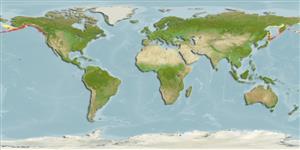>
Perciformes/Cottoidei (Sculpins) >
Agonidae (Poachers) > Anoplagoninae
Etymology: Anoplagonus: Greek, ana = up + Greek, oplon = shield + Greek, gone = birth, generation (Ref. 45335).
More on author: Günther.
Environment: milieu / climate zone / depth range / distribution range
Ecologia
marino demersale; distribuzione batimetrica 8 - 102 m (Ref. 2850). Temperate; - 39°N
North Pacific: Bering Sea to Point Arena, northern California, USA. Korean records may be based on a different species (Ref. 27436).
Size / Peso / Age
Maturity: Lm ? range ? - ? cm
Max length : 15.0 cm TL maschio/sesso non determinato; (Ref. 2850)
Short description
Chiavi di identificazione | Morfologia | Morfometria
Spine dorsali (totale) : 0; Raggi dorsali molli (totale) : 5 - 6; Spine anali: 0; Raggi anali molli: 4 - 5. Dorsal fin small; caudal well rounded; anal small, under dorsal; pectorals with fleshy rays, the last 3 with ends free from membrane (Ref. 6885). Brown dorsally, brownish gray below; darker band from snout to base of pectoral; vertical dark bars on pectoral and oblique bars on dorsal fin formed by mottling, minute spots on anal, faint dark bars across body; caudal fin dark with light patches dorsal and ventral (Ref. 6885).
Often found among rocks (Ref. 2850). Usually caught by shrimp trawlers (Ref. 4925).
Life cycle and mating behavior
Maturities | Riproduzione | Spawnings | Egg(s) | Fecundities | Larve
Eschmeyer, W.N., E.S. Herald and H. Hammann, 1983. A field guide to Pacific coast fishes of North America. Boston (MA, USA): Houghton Mifflin Company. xii+336 p. (Ref. 2850)
IUCN Red List Status (Ref. 130435)
Threat to humans
Harmless
Human uses
Strumenti
Special reports
Download XML
Fonti Internet
Estimates based on models
Preferred temperature (Ref.
123201): 3.4 - 10.1, mean 6.7 °C (based on 240 cells).
Phylogenetic diversity index (Ref.
82804): PD
50 = 0.7500 [Uniqueness, from 0.5 = low to 2.0 = high].
Bayesian length-weight: a=0.00347 (0.00133 - 0.00903), b=3.12 (2.89 - 3.35), in cm total length, based on LWR estimates for this (Sub)family-body shape (Ref.
93245).
Trophic level (Ref.
69278): 3.3 ±0.1 se; based on size and trophs of closest relatives
Resilienza (Ref.
120179): Alto, tempo minimo di raddoppiamento della popolazione meno di 15 mesi (Preliminary K or Fecundity.).
Fishing Vulnerability (Ref.
59153): Low vulnerability (10 of 100).
